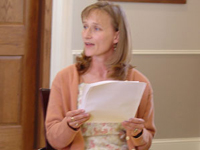- Campuses :
- Twin Cities
- Crookston
- Duluth
- Morris
- Rochester
- Other Locations

center for writing
mwp.umn.edu
Kirsten Jamsen
© 2004
 A Letter to the Students in EngL 3751: The Theory and Practice of Tutoring Writing 1
A Letter to the Students in EngL 3751: The Theory and Practice of Tutoring Writing 1
30 July 2004
Dear EngL 3751 students,
As we begin this course together, I hope for you it will be an experience full of discovery, growth, and reflection. My goal is that you will learn much about yourselves as both writers and teachers of writing. You’ve come to your work as writing consultants because you have been successful in your academic lives and because you want to help other students. But, as you will soon discover (if you haven’t yet already), teaching writing is no more “masterable” than writing itself.
I remember when I first started teaching writing how nervous I was that I had to be the expert. Could I reveal to these students (only 4 years younger than me) that I hated writing? Well, not hated, but I suffered writing—worrying about it, procrastinating, struggling to put words on the page, making endless revisions, losing sleep, just barely making deadlines.
Was I a fraud?
No, I said to myself, I can set a good example, put these students on the right path. I created neat diagrams of the writing process (moving from brainstorming to drafting to revising to editing) and wrote out complicated rubrics describing the perfect A paper. I learned pretty quickly that these handouts didn’t inspire my students any more than they inspired me. I had to be honest with them—and with myself—about how writing is messy and often frustrating.
Sometimes I do my best brainstorming after I’ve written several pages of a draft. Sometimes, I spend an afternoon revising and editing my first sentence, but after that I write freely. Even harder to admit to myself and my students was that writing was painful, so painful that I was often afraid of it. Or, as Red Smith so vividly describes the process: “There’s nothing to writing. All you do is sit down at a typewriter and open a vein.” 2
Then and now, writing for me is a lot like running. It’s murder to get me out the door. Only a deadline (like a 10K race I foolishly signed up for) or a “running date” with a friend will get me out there. The first mile hurts like hell, but then I start to enjoy myself. The endorphins kick in when I’m running, and, before I know it, I’m enjoying the scenery and a breathless conversation with a good friend.
With writing, once I push through the initial resistance and pain, once I get words on a page and begin to play with them, I forget about the struggle. I’m in it, I’m engrossed, and, before I know it, hours have passed, and I have something tangible to show my readers. Having faced my own writing demons so many times over the years—scrubbing the toilet rather than getting started on a paper, staring at a blank computer screen, producing unreadable first drafts, tearing up those drafts in frustration—and survived, I’m a writer built by persistence, proving that anyone can run a marathon (okay, maybe just a half marathon) if she just keeps picking herself up and running a few more steps several days a week.
Recognizing my own struggles and fears as a writer has made me a better teacher of writing. I have tremendous compassion for all the students I work with, even those who just want me to “fix” the paper for them. I, too, have reached out to sympathetic readers and begged them to tell me what to say, so I didn’t have to wrestle with the messy thoughts in my head any longer.
But, I have no desire to be the provider of correct prose for my students; I would much rather help them with their writing by sharing my own struggles and strategies, by asking the questions they need to help them figure out what they want to say, and by just being quiet and listening supportively as they work through their thinking aloud or on paper. Rather than pretend to be the “writing expert,” I would much rather work from my core beliefs about teaching writing (inspired by Dan Kirby’s “Notes to Myself as a Writing Teacher” 3):
1. My primary job as a writing teacher is to motivate and coach my students as they practice their writing and revising.
2. I strive to create stronger, more fluent, more thoughtful writers—not better papers.
3. For my students to be motivated to grow as writers, I must create a rich, safe, yet challenging writing community in my classroom and in my writing center.
4. I need to model the practices and products of real writers (myself included) to invite students to stretch and experiment.
I hope you will, during this course, begin to discover and reflect on your beliefs about teaching writing, as I have begun to do here. I welcome you into this messy, sometimes painful, sometimes joyful writing and teaching community—a place where compassion, humor, and honesty rule.
All the best,
Kirsten
1 Inspired and supported by the members of my summer writing group: Shelly Bertrand, Bob, Cudahy, Elizabeth Hygrell, and Jane Kepple Johnson.
2 Thank you, Muriel, for this wonderful quotation.
3 Described in Dan Kirby, Dawn Latta Kirby, and Tom Liner, Inside Out: Strategies for Teaching Writing, 3rd Edition, Portsmouth, NH: Heinemann, 2004, 1-10.



